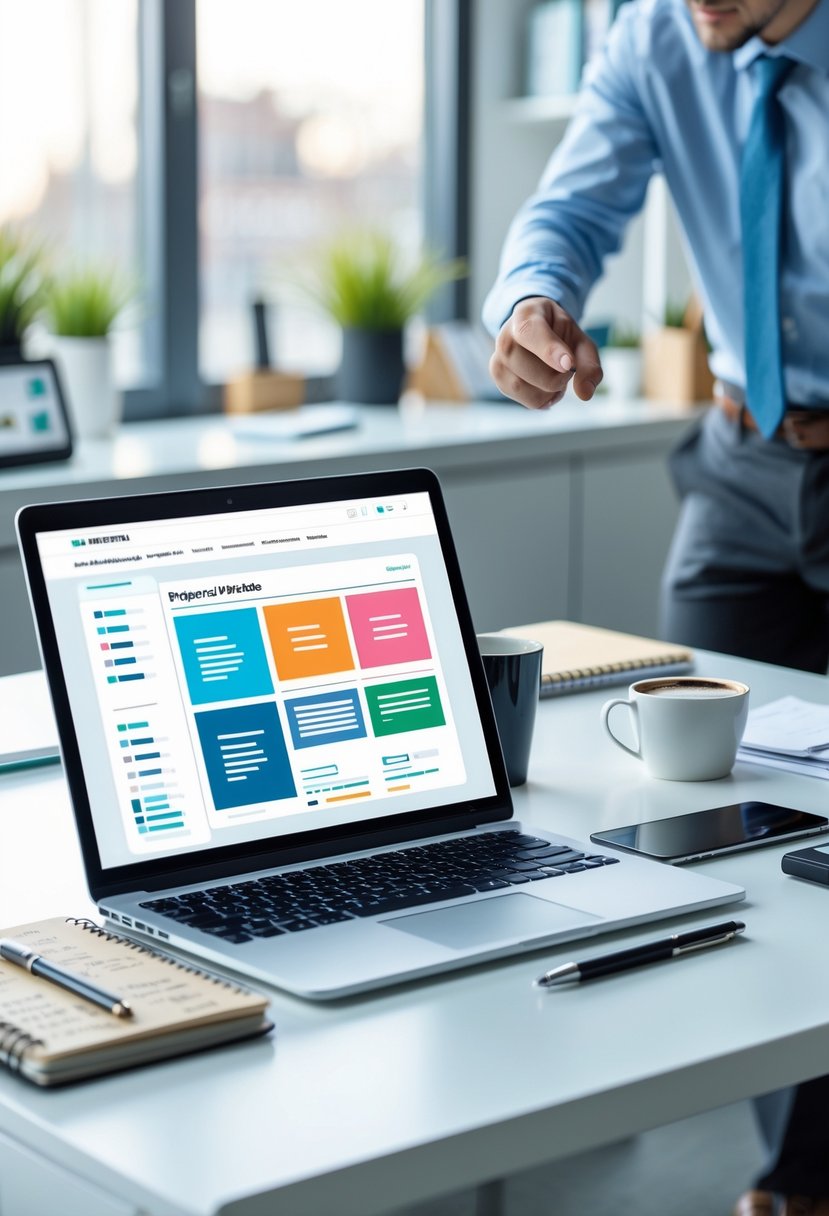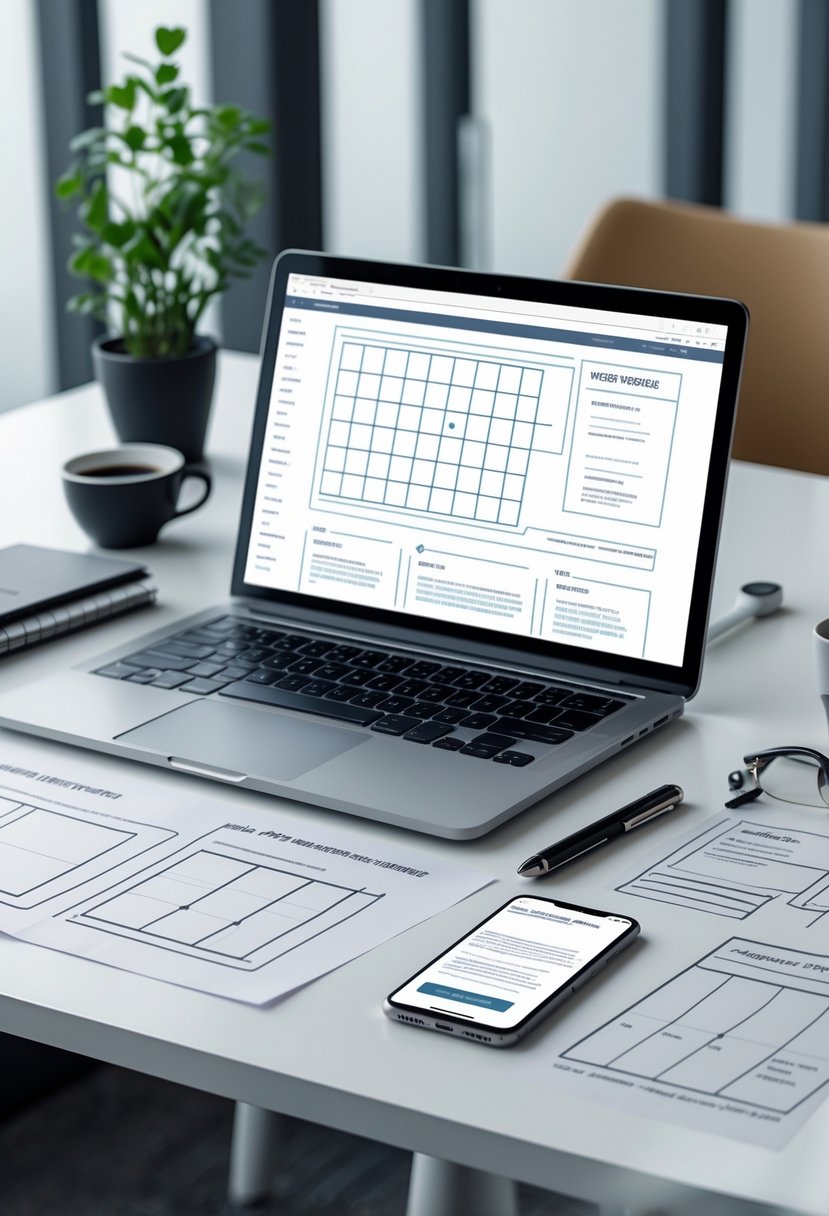Choosing the Right Domain Name and Web Hosting

Picking a domain name and web hosting provider is one of those things you really want to get right from the start. Your domain is your brand’s home online, and the host you choose keeps your site up and running.
Registering a Custom Domain
A good domain name makes a business easier to find and remember. Go for something short, simple, and as close to your business name as you can get.
Stick to letters, numbers, or hyphens—no weird spellings that’ll trip people up. A custom domain just looks more professional than a generic one from a free host or builder.
It builds trust, and honestly, it’s easier to talk about or put on a business card. Try to register your domain as soon as you can, even if your website isn’t ready yet.
Domains can get snapped up quickly, and it’s a pain if someone else grabs your perfect name. Use a reputable domain registrar or your web host’s built-in domain services—they usually make the process pretty easy.
If privacy protection is an option, grab it. It keeps your personal info off public records, which is always nice.
Selecting a Reliable Web Host
Web hosting services are what keep your website live on the internet. You want a host that’s reliable—nobody likes downtime.
Look for 24/7 support, solid security, and good reviews from other business owners. There are a few types of hosting out there: shared, VPS, and dedicated.
Shared hosting is cheap and fine for small sites, but you’re sharing resources with others. VPS and dedicated hosting give you more control and power, so they’re better if you expect to grow.
Check what each host offers for storage, bandwidth, and features. Some even throw in a free domain for the first year, which is handy.
If you want to dig deeper, this Web Hosting Guide for Beginners is pretty helpful.
Understanding TLDs and Domain Registration
A TLD (top-level domain) is just the ending of your domain, like .com, .net, or .org. The TLD you pick can shape how people see your business.
For most small businesses, .com is the way to go. It’s familiar and people tend to trust it.
If .com’s taken, you can look at .co, .biz, or even a country-specific TLD like .us or .uk. Some TLDs cost more or have rules, so double-check before you buy.
Domains are usually paid for yearly, and you’ve got to renew to keep your name. Managing your domain through your host can make things easier since billing and support are all in one spot.
If you want more details, check this overview of domain names and web hosting.
Planning Your Business Website Structure

Planning your website isn’t just about looks—it’s about making sure it works for your business and your visitors. Thinking about your audience and layout helps your site actually do its job.
Defining Your Target Audience
Figure out who’s going to visit your site and what they’re hoping to find. When you know your customers’ needs and habits, it’s easier to decide what info to include.
If you’re a small business, your audience might be local shoppers, service seekers, or maybe even potential partners. Ask yourself a few questions:
- How old are they? What’s their background?
- What problems are they trying to solve?
- Are they mostly on phones, tablets, or computers?
Write up a quick profile for your main audience groups. It’ll help you shape every part of your site, from your homepage to your contact details.
Outlining Site Pages and Navigation
A simple, organized structure makes it easier for visitors to find what they need. Start by listing out the main pages you’ll need:
| Main Pages | Purpose |
|---|---|
| Homepage | First impression, company summary |
| About Us | Share your story and values |
| Services or Products | Lists what you offer |
| Contact Information | Shows how to reach you |
Keep your navigation menu straightforward. Use clear names for each page.
Put your logo in the top left and keep the menu visible on every page. A contact link in the main menu is always a good idea.
Add call-to-action buttons like “Buy Now” or “Request a Quote” so people can get to your main offers fast. If you want more on structuring business websites, here’s a planning and management guide.
Establishing Your Branding Elements
Branding makes your business memorable and helps you stand out. Your logo should be easy to see on every page.
Pick a color scheme that fits your business vibe, and stick with the same fonts and styles throughout your site. Make sure your brand image matches your business values.
Use high-quality photos and graphics—they make a big difference. Keep your contact info in the header or footer so people don’t have to hunt for it.
If you’re not sure about branding, talking to a web designer can help. There are some useful tips for launching a business website with strong branding.
Choosing a Website Builder or Content Management System

The tool you pick to build your website affects how easy it is to update and manage things later. It also decides what features you get and how much control you have.
Comparing WordPress, Wix, and Joomla
WordPress is super popular for a reason. It’s flexible, open-source, and has a ton of themes and plugins.
If you want a blog or plan to add lots of features, WordPress is a solid choice. You might need a bit of tech know-how, but most hosts offer easy one-click installs.
Wix is all about drag-and-drop. No coding needed, just pick a template and start editing.
It’s fast to launch, but you’ll have fewer customization options than with WordPress. Also, moving your site away from Wix later can be tricky.
Joomla is another open-source CMS. It’s got more built-in features than WordPress, but isn’t quite as beginner-friendly.
It’s good for people who want flexibility without adding tons of plugins, though setup can be a little more complicated.
Here’s a quick comparison:
| Platform | Ease of Use | Customization | Best For |
|---|---|---|---|
| WordPress | Moderate | High | Blogs, business |
| Wix | Very High | Low-Medium | Quick launches |
| Joomla | Moderate | High | Tech-savvy users |
If you want a deeper dive, this guideline covers more details.
Evaluating E-Commerce Platforms
Planning to sell online? The right e-commerce platform makes things a lot easier.
Shopify is built for online stores. It’s simple to set up, secure, and handles products and payments without much hassle.
You don’t need coding skills, but you do pay monthly fees and get less design freedom compared to open-source options. WooCommerce is a WordPress plugin that turns your site into a full store.
It’s super customizable and grows with you, but you’re in charge of updates and security. Wix has a built-in e-commerce option too, which is fine for small stores.
For bigger inventories or custom checkout features, Shopify or WooCommerce are usually better picks. Think about security, transaction fees, and payment options before deciding.
If you want more info, check out this study on web development platforms.
Designing a User-Friendly and Mobile Responsive Website

A clean layout and quick loading times keep visitors on your site. Mobile-friendly designs and simple navigation make a great first impression.
Selecting Website Templates and Free Themes
The template you pick really shapes your site’s look and feel. Good templates make info easy to find.
Most builders offer free themes that already work on phones and tablets. Go for something clean and simple—it helps people navigate.
Choose easy-to-read fonts and make sure text isn’t too tiny on mobile. Lists, call-to-action buttons, and some breathing room on the page all help guide visitors.
Most platforms let you tweak colors and add your logo, so your brand shines through. Check theme reviews and preview them on different devices before you commit.
That way, you can avoid themes that are slow or buggy. A good theme saves you headaches down the road.
Optimizing for Mobile Responsiveness
A mobile responsive site is a must these days. People visit business websites from their phones all the time.
Responsive sites adjust to any screen size, so your site looks good everywhere. Test your site on a phone and tablet to make sure menus, forms, and images work right.
Keep navigation simple and make buttons big enough to tap. Little things like this can make a big difference for mobile users.
Fix any issues like overlapping text or images that don’t resize. Following modern web design guidelines helps you reach more customers and look more professional.
Improving User Experience and Page Load Speed
User experience is all about how fast and easy your website is to use. Slow sites drive people away.
Make your site faster by shrinking image sizes, cutting down on plugins, and using clean code. Here’s a quick table for speeding things up:
| Factor | How to Improve |
|---|---|
| Image Size | Compress images |
| Code Quality | Minify CSS/JS files |
| Plugins | Remove unused plugins |
Fast sites rank better in search engines and are easier to use on mobile data. Keep menus simple and avoid annoying pop-ups.
Make sure buttons and links are easy to tap, especially on phones. These little tweaks make your site feel polished and friendly.
If you want more on responsive design, this guide is worth a look.
Creating Informative and Engaging Content
High-quality content is what helps people find your business, learn what you do, and see why they should care. It keeps visitors interested and nudges them to reach out or buy something.
Developing a Content Strategy
First things first—figure out who your audience is and what they’re looking for. What questions do they have? What problems are they trying to solve?
Plan your website content around those needs. Check out what your competitors are doing, but don’t just copy them—look for gaps you can fill.
Set a clear goal for each page. Your homepage should give people a quick intro to your business, while your services page needs to explain what you actually offer. Jot down a list of topics and keywords your audience might type into Google.
A content calendar is handy for staying organized. It helps you keep your info fresh and avoid falling behind.
Before you start writing, outline your content. That way, you won’t get off track or add unnecessary fluff.
If you want to dive deeper into content planning, Content Rules is a pretty solid resource.
Incorporating Multimedia and Images
Photos, graphics, and videos can really make your content pop. They help explain things and catch people’s attention.
Use images that are clear and actually relate to what you’re talking about. Show off your products, introduce your team, or just break up big blocks of text.
Go for high-quality images that look good on any device. Infographics are great for sharing data or explaining steps quickly.
Videos are perfect for tutorials or showing real customer stories. If you want to boost engagement, try adding image galleries or interactive charts.
Always add captions, descriptions, and alt text to your images. It helps with accessibility and gives you a little SEO boost.
If you want more ideas for using visuals, the book Visual Content Marketing has some helpful tips.
Key Pages: About Page, Services Page, Portfolio, and Landing Page
About Page: Share your story and introduce your team. Let people know what makes your business unique.
Be honest, keep it simple, and don’t be afraid to show some personality.
Services Page: List each service with a short, clear description. Highlight the benefits and answer common questions.
Portfolio: Show examples of your work. Use images and quick descriptions to help build trust.
Landing Page: Focus on one main offer or action, like signing up for a newsletter. Keep it clear and remove extra distractions.
Remember to keep these pages updated so your info stays relevant.
If you want advice on making these pages work together, Mastering Web 2.0 is a good read.
Effective Use of Calls to Action
A call to action (CTA) tells visitors what you want them to do next. Think “Contact Us,” “Request a Quote,” or “Buy Now.”
Keep your CTAs short, clear, and easy to spot. Use action words so people know exactly what will happen.
Put CTAs where people will notice them, like after a service description or in a banner at the top. Too many CTAs can get confusing, so stick to one or two per page.
Try out different messages, colors, and spots to see what gets the best response. For more on this, the guide Engage has some proven ideas.
Optimizing for SEO and Growing Your Online Presence
If people can’t find your business online, well, that’s a problem. SEO, quality content, and digital outreach are how you get noticed.
Implementing SEO Best Practices
Start by researching keywords your audience might use. Sprinkle them into page titles, meta descriptions, headings, and your main content.
Good keywords help search engines connect your site with the right people.
Pay attention to technical SEO too. Make your site mobile-friendly, speed things up, and use HTTPS for security.
Make sure images have descriptive alt text and use a clear internal link structure. This helps search engines understand and rank your pages.
Create and submit an XML sitemap so search engines can find all your pages. Set up Google Analytics and Search Console to keep an eye on how your site is doing.
Enhancing Search Engine Rankings
High rankings matter if you want more visitors. Keep your website updated with fresh, useful info.
Search engines like sites that are active and helpful. Encourage other trusted websites to link to yours—these backlinks can really boost your authority.
Jump into industry blogs or forums to build relationships and maybe earn a few relevant links.
Track your website’s performance with tools that show rankings and popular pages. If you notice a dip, check for broken links, slow load times, or duplicate content.
Ranking Factors Table:
| Factor | Importance | Action |
|---|---|---|
| Fresh content | High | Add new posts regularly |
| Quality backlinks | High | Earn links from trusted sites |
| Website speed | Medium | Use image compression, caching |
| Mobile friendliness | High | Use responsive design |
| Secure connection | Medium | Install SSL certificate |
Blogging and Content Marketing
Blogging is a great way to share updates, tips, and insights with your audience. It can bring in more visitors and support your SEO without feeling forced.
Write about topics your customers care about. Use plain language and answer their common questions.
Regular posts show search engines your site is active. Images, videos, and infographics can make your posts more interesting.
End each post with a call to action, like an email signup or a link to your services. Don’t forget to share your blog posts on social media to reach more people.
If you want to learn more, content marketing resources are everywhere.
Leveraging Digital Marketing and Social Media
A solid digital marketing strategy mixes your website with email, social media, and other tools. Share your stuff on Facebook, LinkedIn, Instagram—wherever your audience hangs out.
Start a mailing list and send regular updates or newsletters. Email is a direct way to keep people in the loop about new posts, products, or deals.
Use social media to actually talk to your customers. Reply to comments and messages. Try simple ads to reach new people.
Mixing these approaches helps you build trust and grow your audience. Curious about more strategies? Check out this article.
Preparing for Launch and Beyond
Launching a website isn’t just about hitting “publish.” You’ve got to make sure everything works, track your progress, and keep your pricing current so visitors have a smooth ride.
Testing Website Functionality
Before you go live, test every part of your site to catch any bugs. Click all the links, fill out forms, and run through checkout if you have one.
Test it on both computers and phones—sometimes things break on mobile and you wouldn’t even know.
Here’s a quick checklist:
- Navigation menus
- Product pages
- Sign-up and login forms
- Payment gateway
- Search function
- Images and videos
Ask friends or coworkers to test your site too. They’ll probably find stuff you missed.
If you sell things, do a test order to make sure payments go through. Want more launch tips? This small business website guide is useful.
Setting Up Analytics and Tracking
Set up analytics before launch day. Google Analytics or similar tools help you see who’s visiting, what they’re doing, and where they’re coming from.
Figure out your main goals—like email sign-ups or completed purchases. Add tracking codes (or pixels) to the right pages so you can measure what’s working.
Here’s a simple table of what to track:
| Metric | Why It Matters |
|---|---|
| Number of Visitors | Shows your reach |
| Bounce Rate | Measures interest |
| Conversion Rate | Tracks sales or sign-ups |
| Traffic Sources | Finds best marketing channels |
Check your analytics often and tweak your site or campaigns as needed.
Managing Pricing and Updates
Getting your pricing right is key for attracting customers. See what your competitors charge and what your customers expect.
Factor in your costs and the value you offer when deciding on prices. Display prices clearly so there’s no confusion.
Use a content management system (CMS) or e-commerce platform to make updates easy. That way, you can quickly adjust prices if things change.
Always keep your pricing up to date. If you need to raise prices, let customers know in advance.
For more on handling pricing and launches, this guide is worth a read.
Frequently Asked Questions
Building a small business website isn’t rocket science, but you do need clear steps, good tools, and a bit of strategy. The right content and solid SEO help your business grow online.
What are the essential steps to creating a website for a small business?
Start by figuring out your main goal—maybe you want more customers, or you just want to share what you do. Pick a domain name that’s easy to remember and fits your brand.
Choose a hosting provider and a website builder that feels right for you. Pick a simple template, add your content, and test everything before launching.
If you want a handy checklist, try 100 questions to ask before building a website.
What are some cost-effective solutions for building a business website?
A lot of website builders offer free or low-cost plans. Wix, Weebly, and WordPress.com all let you make a simple site without spending much.
If you want extra features or your own domain, you can upgrade later. Using templates keeps design costs down.
Need help budgeting? Check out Launching a website for your small business.
What is the best platform to create a free website for a business?
Wix, WordPress.com, and Weebly all have free options for basic business sites. They come with drag-and-drop editors and ready-made templates.
If you want more control or a custom domain, you’ll need to pay a bit. Still, you can make a solid, professional site for free.
How can I design a website for my business with no prior experience?
Use a website builder with templates—most don’t require any coding. Pick a template that matches your vibe, then swap in your own text and images.
If you get stuck, there are tons of tutorials and guides in the help sections.
What content should be included on a small business website?
Include your business name, a quick summary of your services or products, contact info, and your hours. An “About Us” page helps visitors connect with your story.
Add a simple navigation menu, clear pricing, testimonials, and a contact form so people can reach you easily.
How do I optimize my business website for search engines?
Think about the words your customers might actually type into Google or Bing. Try to use those keywords naturally throughout your website’s text.
Don’t forget to write clear, descriptive titles and headings. They help both visitors and search engines understand what your pages are about.
Keep your page URLs simple and easy to read. Also, add alt text to your images—this helps with accessibility and can boost your SEO a bit.
Your site should load fast. If it’s slow, people might just leave before seeing what you offer.
Make sure your website looks good and works well on mobile devices. Honestly, most folks are browsing on their phones these days.
If you want to dig deeper, you might want to check out the tips in The design of sites: Patterns for creating winning web sites.